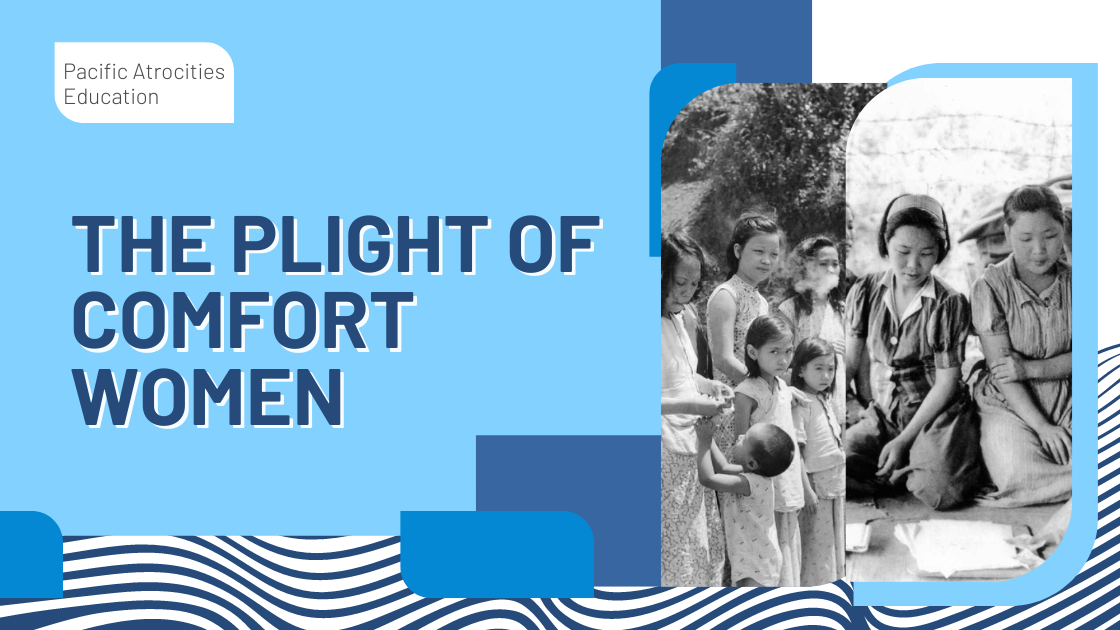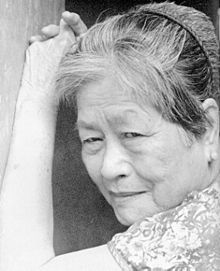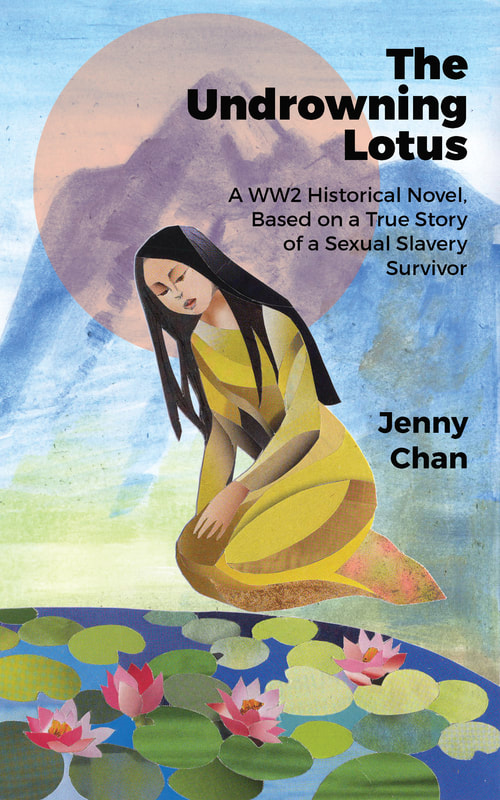|
by Sophia Maroulis Comfort women is the euphemistic term used to describe the estimated 200,000 women and girls that the Imperial Japanese army forced into systematic military sexual slavery from the early 1930s to the end of WWII (Soh 1227). Comfort women is a widely disputed term, both because it conceals the violent nature of sexual slavery and because many comfort women were minors between the ages of 13-17. However, most historians continue to use this term to identify this specific instance of military-sponsored and organized sex slavery compared to other instances of human trafficking. Comfort women were taken from Asian countries occupied by Japan. They were often taken under false pretenses through employment offers for jobs like cleaning, housekeeping, waitressing, and nursing, while others were coerced, and some were outright abducted (Tanaka 38). An estimated 80% of comfort women were from Korea—as Japan had colonized Korea in 1910 and exerted significant influence—but there were also girls taken from countries including China, Taiwan, the Philippines, Indonesia, and Burma (Soh 1227). However, the exact numbers are unknown because many comfort women died during WWII, and surviving comfort women kept silent due to intense stigma and trauma until the 1990s. Another reason is that Japan destroyed many incriminating documents at the end of the war. Some comfort stations existed in the early 1930s, but it wasn't until after the 1937 Nanjing Massacre (Rape of Nanjing)—where Japanese soldiers killed hundreds of thousands of Chinese civilians, and tens of thousands of people were raped— did the Imperial Japanese Army created the Comfort Women system in an attempt to control their soldiers' sexual activity. The comfort stations were designed to simultaneously protect the moral reputation of the Imperial Japanese Army, minimize anger from civilians in occupied territories, and prevent troops from contracting Venereal Disease (Tanaka 3). The implementation of the comfort women system did not, however, prevent Japanese soldiers from raping civilians or considerably reduce the spread of VD among troops. Japan had a culture of legalized prostitution prior to 1956. Initially, the Imperial Japanese military brought professional Japanese prostitutes to work for the military. However, the military could not recruit enough and quickly turned to "recruiting" women and girls from occupied territories. The military and the recruiters they hired deliberately sought young, unmarried girls because they wanted virgins to reduce the spread of VD (Soh 1228). Comfort Women were disproportionately from poor families, who either accepted false job offers out of necessity or did not have the money or influence to resist coercion. The ratio of comfort women to soldiers is estimated to have ranged from about 1:35 to 1:100, with an average of 1:50 (Hicks 311). The scarcity of comfort women and the high demand for Japanese soldiers resulted in a particular comfort woman being raped by dozens of soldiers daily (Tanaka 1). Former comfort woman, Maria Rosa Henson, described how "every day, from two in the afternoon to ten in the evening, the soldiers lined up outside my room . . . I did not even have time to wash after each assault. At the end of the day, I just closed my eyes and cried" (Tanaka 1). Comfort women lived in perpetual fear of being killed and were often beaten and maimed for resisting soldiers. Their movement and ability to leave their comfort stations were severely limited. Some comfort women were additionally also forced to cook and clean for soldiers. Because soldiers rarely used military-issued condoms, many pregnant comfort women were forced to have abortions or were even killed, and most surviving comfort women became infertile from the injections that army doctors gave them for venereal disease. Although the Japanese military referred to comfort women as "prostitutes," and soldiers paid to use comfort stations, which is controversial. Comfort women did not choose to "work," most comfort women never received their promised compensation for their "work" (the money the soldiers paid went to the comfort station managers). The few that received compensation received it in the Japanese military yen, which had no value once the war ended (Tanaka 56). Comfort women were controlled and commodified to such a degree that most scholars and UN reports agree that "sexual slavery" is the most applicable term. While the exact numbers are unknown, a 1998 UN report by G.J. McDougal estimated only 25 percent of comfort women survived their sexual enslavement ("Number of Comfort Stations and Comfort Women"). The other estimated 75 percent of Comfort Women died by the end of WWII through being attacked alongside Japanese soldiers by allied forces, murder by Japanese soldiers, suicide, or death from medical complications from their horrific experiences. Surviving Comfort Women kept silent about their experiences due to the trauma and heavy stigma that survivors of sexual violence experience. In 1991, at the age of 67, Kim Hak-Sun shared her testimony about her experience as a comfort woman. This sparked many former comfort women to follow suit and led to investigations into the largest covered-up atrocity that the Imperial Japanese Army committed. In 1992, Japanese Prime Minister Kiichi Miyazawa apologized to comfort women, but Japan has largely resisted taking full responsibility for the complete truth about comfort women. Decades after the war, victims are still negotiating terms of reparations and steps to go forward and heal. Most of the victims have passed on, and their emotional wounds were unhealed and their stories untold. References Hicks, George, et al. "The 'Comfort Women.'" The Japanese Wartime Empire, 1931-1945, edited by Peter Duus et al., Princeton University Press, 1996, pp. 305–23. JSTOR, https://doi.org/10.2307/j.ctv1mjqvc6.14. Accessed 3 Jun. 2022. McDougall, Gay J. "Systematic rape, sexual slavery, and slavery-like practices during armed conflict: final report / submitted by Gay J. McDougall, Special Rapporteur." Geneva: UN, 22 June 1998. https://digitallibrary.un.org/record/257682?ln=en "Number of Comfort Stations and Comfort Women." Digital Museum The Comfort Women Issue and the Asian Women's Fund, 5 June 2022. https://www.awf.or.jp/e1/facts-07.html. Soh, Chunghee Sarah. "The Korean 'Comfort Women': Movement for Redress." Asian Survey, vol. 36, no. 12, 1996, pp. 1226–40. JSTOR, https://doi.org/10.2307/2645577. Accessed 3 Jun. 2022. Tanaka, Yuki. Japan's Comfort Women: Sexual Slavery and Prostitution During World War II and the US Occupation, Taylor & Francis Group, 2001. ProQuest Ebook Central, https://ebookcentral.proquest.com/lib/whitman/detail.action?docID=170421. from https://ebookcentral.proquest.com/lib/whitman/reader.action?docID=170421&ppg=26 Related Reading:
0 Comments
Leave a Reply. |
- Home
- Stories
-
Internship
- Summer 2024 Internship
- Summer 2023 Internship
- Fall 2022 Internship
- Summer 2022 Internship
- Summer 2021 Internship
- Fall 2020- Spring 2021 Internship
- Summer 2020 Internship
- Fall 2019 Internship
- Summer 2019 Internship >
- School Year 2018-2019 Internship
- Summer 2018 Internship >
- Fall 2017 Internship
- Summer 2017 Internship >
- Books
- Archives
-
Resource Page
-
Supplementary Research Guides
>
- Unit 731 - Guide >
-
Philippines' Resistance - Guide
>
- Philippines World War II Timeline
- The Japanese Invasion & Conquest of the Philippines
- Bataan Death March
- Formation of Underground Philippines Resistance
- Supplies of the Guerrilla Fighters
- The Hukbalahap
- Hunter's ROTC
- Marking's Guerrillas
- United States Army Forces in the Philippines of Northern Luzon (USAFIP-NL)
- The Aetas
- Chinese and Filipino-Chinese Nationalist Guerrilla Units
- The Female Faces of the Philippine Guerrillas
- Rising Sun Flag - Guide >
- Pinay Guerrilleras - Guide >
- Fall of Singapore - Guide >
- Three Years and Eight Months - Guide >
- Siamese Sovereignty - Guide >
- The Khabarovsk War Crimes Trial - Guide >
- Unit 731 Cover-up : The Operation Paperclip of the East - Guide >
- Marutas of Unit 731 - Guide >
- Prince Konoe Memoir - Guide >
- Competing Empires in Burma - Guide >
- Battle of Shanghai - Guide >
- Ishi Shiro - Guide >
- Taiwan The Israel of the East - Guide >
- Seeking Justice for Biological Warfare Victims of Unit 731 - Guide >
- Rice and Revolution - Guide >
- Clash of Empires - Guide >
-
Hunger for Power and Self-SufficiencyI - Guide
>
- The Influence of War Rations on Post-War Culinary Transformations
- How World War II Complicated Food Scarcity and Invention
- American Military Innovations
- Government-Sponsored Food Inventions in Europe during World War II
- Feeding the Army: The Adaptation of Japanese Military Cuisine and Its Impact on the Philippines
- Mixed Dishes: Culinary Innovations Driven by Necessity and Food Scarcity
-
Denial A Quick Look of History of Comfort Women and Present Days’ Complication - Guide
>
- The Comfort Women System and the Fight for Recognition
- The Role of Activism and International Pressure
- The Controversy over Japanese History Textbooks
- The Sonyŏsang Statue and the Symbolism of Public Memorials
- Activism and Support from Japanese Citizens
- The Future of Comfort Women Memorials and Education
- Echoes of Empire: The Power of Japanese Propaganda - Guide >
- Lesson Plans >
-
Supplementary Research Guides
>
|
Pacific Atrocities Education
730 Commercial Street San Francisco, CA 94108 415-988-9889 |
Copyright © 2021 Pacific Atrocities Education.
We are a registered 501 (c)(3) charity. |
- Home
- Stories
-
Internship
- Summer 2024 Internship
- Summer 2023 Internship
- Fall 2022 Internship
- Summer 2022 Internship
- Summer 2021 Internship
- Fall 2020- Spring 2021 Internship
- Summer 2020 Internship
- Fall 2019 Internship
- Summer 2019 Internship >
- School Year 2018-2019 Internship
- Summer 2018 Internship >
- Fall 2017 Internship
- Summer 2017 Internship >
- Books
- Archives
-
Resource Page
-
Supplementary Research Guides
>
- Unit 731 - Guide >
-
Philippines' Resistance - Guide
>
- Philippines World War II Timeline
- The Japanese Invasion & Conquest of the Philippines
- Bataan Death March
- Formation of Underground Philippines Resistance
- Supplies of the Guerrilla Fighters
- The Hukbalahap
- Hunter's ROTC
- Marking's Guerrillas
- United States Army Forces in the Philippines of Northern Luzon (USAFIP-NL)
- The Aetas
- Chinese and Filipino-Chinese Nationalist Guerrilla Units
- The Female Faces of the Philippine Guerrillas
- Rising Sun Flag - Guide >
- Pinay Guerrilleras - Guide >
- Fall of Singapore - Guide >
- Three Years and Eight Months - Guide >
- Siamese Sovereignty - Guide >
- The Khabarovsk War Crimes Trial - Guide >
- Unit 731 Cover-up : The Operation Paperclip of the East - Guide >
- Marutas of Unit 731 - Guide >
- Prince Konoe Memoir - Guide >
- Competing Empires in Burma - Guide >
- Battle of Shanghai - Guide >
- Ishi Shiro - Guide >
- Taiwan The Israel of the East - Guide >
- Seeking Justice for Biological Warfare Victims of Unit 731 - Guide >
- Rice and Revolution - Guide >
- Clash of Empires - Guide >
-
Hunger for Power and Self-SufficiencyI - Guide
>
- The Influence of War Rations on Post-War Culinary Transformations
- How World War II Complicated Food Scarcity and Invention
- American Military Innovations
- Government-Sponsored Food Inventions in Europe during World War II
- Feeding the Army: The Adaptation of Japanese Military Cuisine and Its Impact on the Philippines
- Mixed Dishes: Culinary Innovations Driven by Necessity and Food Scarcity
-
Denial A Quick Look of History of Comfort Women and Present Days’ Complication - Guide
>
- The Comfort Women System and the Fight for Recognition
- The Role of Activism and International Pressure
- The Controversy over Japanese History Textbooks
- The Sonyŏsang Statue and the Symbolism of Public Memorials
- Activism and Support from Japanese Citizens
- The Future of Comfort Women Memorials and Education
- Echoes of Empire: The Power of Japanese Propaganda - Guide >
- Lesson Plans >
-
Supplementary Research Guides
>



